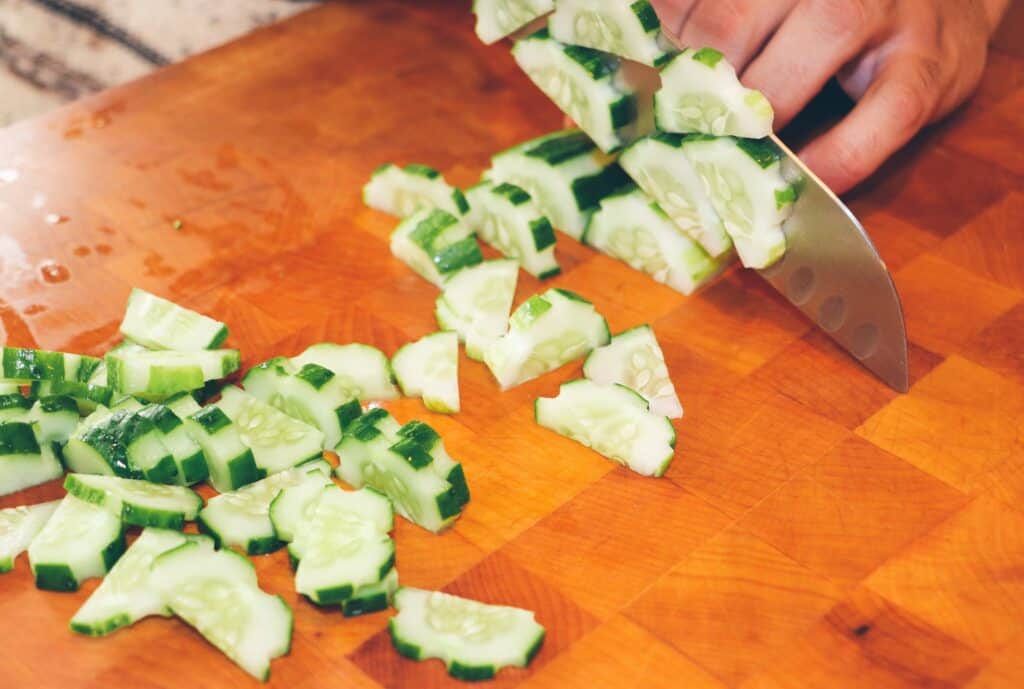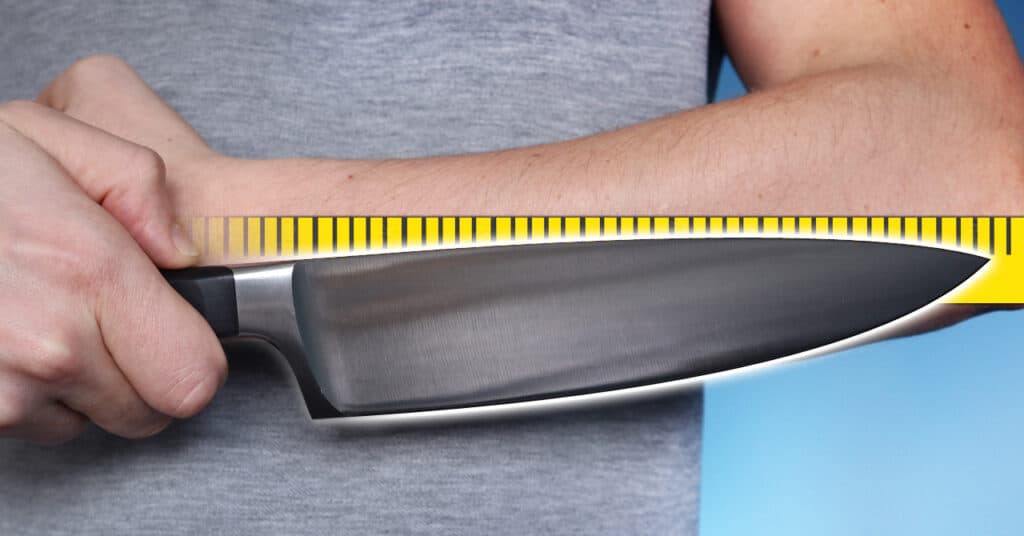
Having good knife skills can make cooking a joy. But get it wrong and you could be in a messy, and painful situation! Having an object specifically designed to easily slice through flesh moving up and down right next to your fingertips is always going to pose a bit of danger, but if you place your hands in the right position and pay respect to your knife, your chances of injuring yourself will be massively reduced and you’ll be able to chop more quickly and with greater accuracy.
Ensure your knife is sharp and that you have a firm grip of the food, laid down on a cutting board. Hold the food using your palm and the tips of your fingers, with your fingers pointing down into the food and your end knuckles slightly bent to protect your fingers from the blade. Bring the blade over the food with the tip touching the board and the handle raised. Gently rock the blade down and forward, back up and repeat.
How to hold a knife
Always hold the knife in your dominant hand; right hand for right-handers, left hand for left-handers.
You want to get a good strong grip on the knife, this is where many people go wrong. A common mistake is using your index finger to steady the blade, by holding the handle and planting your index finger on the back of the blade, this is not good practice.
Using your index finger doesn’t stabilize the blade, your index finger is just too wobbly. It can also lead to strain in your hand with prolonged use. If that is how you currently use a knife, it would be better in the long run to learn a new method. I know it can be hard to change a habit, but just try it!
There is no ‘right’ way to hold a knife, but using your index finger to stabilize the blade is generally considered wrong.
It isn’t good for safety and it will put more strain on your hand.
There are three general techniques which are most commonly used to hold a knife:
Choking the blade – This is where you hold both the handle and part of the blade. Hold the handle firmly in your palm and use your index finger and thumb to clamp the blade.
Handle only – This is where you just firmly grip the handle, it can give you a little less control than choking the blade but many find it more comfortable. You will need a knife which has good grip on the handle.
Thumb on top of the blade – This is less common than the above techniques but placing your thumb on top of the blade gives you WAY more stability than using your index finger.
This video does a great job of showing each method:
How to hold the food
The crucial part of chopping food safely is positioning your fingers in the right way. If you’re right-handed, hold the knife firmly in your right hand.
Using a firm hard service or chopping board lay the food item down. Depending on the size of the thing your cutting hold it with two, three or four fingers.
The main mistake people make when using a knife is to hold the item they’re about cut with outstretched fingers like you might hold a computer mouse. This means that if you make any little mistake with the knife, the end of your fingers will be the first thing it hits! This is not good practice.
Your fingers should be pointing down, into the thing you’re about to cut. Slightly bent near the end of your fingers so that the knuckles closest to your fingertips arch slightly further than the rest of your hand, with your fingertips pointing slightly inwards.
Your knuckles will provide protection to your fingertips, if something does go wrong then the side of the blade will be stopped but your knuckles before you can hit your fingertips.
Cutting the food. Slice don’t saw.
If you want to cut your food quickly and safely then it’s really important to keep a well maintained and sharp knife. A blunt knife is going to make your work SO much harder than it should be and will make it much more likely that you’ll injure yourself.
A sharp knife should easily be able to slice through meat and vegetables in one long cut. Start with the tip of the knife touching the chopping board, with the handle raised and the food item being held under the blade.
You should be able to gently bring the blade down and forward, so the blade is slicing straight through the food in one long stride. To continue chopping; once the cut has been made raise the knife back up and move it along to the left, slice again using the same rocking motion.
The more comfortable you get using a knife in this way the faster you’ll be able to go.
Here’s a great video of Gordon Ramsay showing how to position your hand to protect your fingers.
Go at your own speed
It’s really important to not try and chop too fast too quickly when it comes to any knife skills. It is much better to do it right, safely and slowly than wrong and fast.
Notice in the above video how Gordon is actually chopping very slowly but gets the overall job done pretty quickly, with the onion diced perfectly. That’s much better than going too fast and doing it wrong.
Holding the food item in the correct way will massively reduce the risk you pose to yourself when using a knife, and ultimately as you get more practice, that extra confidence will naturally allow you to go faster.
Keep a sharp knife
First of all, you want to make sure you have a good and sharp knife. Any chef will tell you that having a sharp knife will actually reduce the risk of cutting yourself, as it makes slicing through veg and meat an absolute breeze and you can be really precise with your cuts.
A blunt knife can mean that you’re having to hack and saw your way through the food, which is not a good way to know where a knife will end up. A sharp knife will easily cut straight through a tomato or onion. A blunt knife may find itself deviating from the straight path you want, and right onto your fingertips! Ouch!
Choose the right knife
Far too often people use the wrong knife for the wrong job, don’t be scared of using a larger knife more often. Using small paring knives for larger tasks can actually be more dangerous and will take a lot longer.
I see people using a tiny little paring knife or utility knife all the time for food which they should be using a proper chef’s knife for. Generally, a smaller kitchen knife should be reserved for very small tasks such as peeling and deseeding.
Larger than that and you should usually be using a chef’s knife for general cutting and chopping tasks. More specific tasks will require a more specific tool, such as a bread knife or carving knife.
As the chef’s knife is by far and away the best all-rounder knife, this article is going to be focused on using a chef knife for cutting food, although the basic principles can be used for all manner of knife work.

